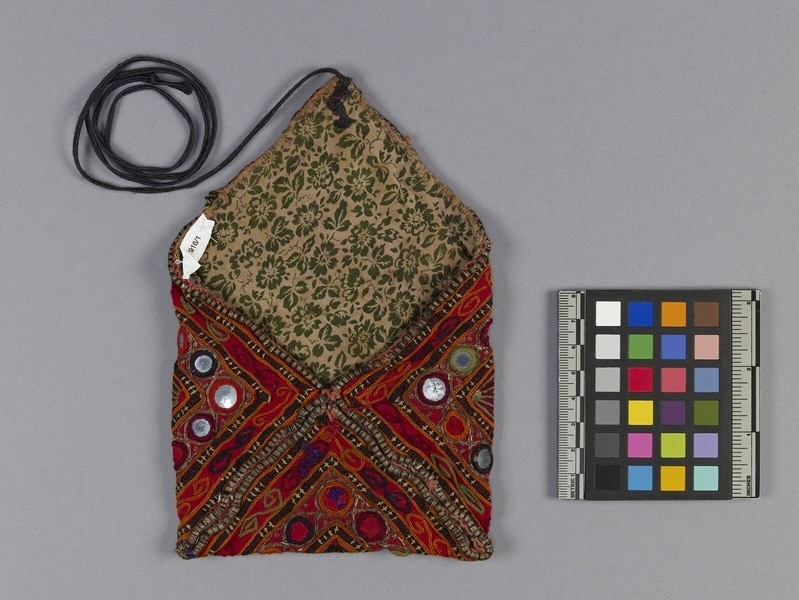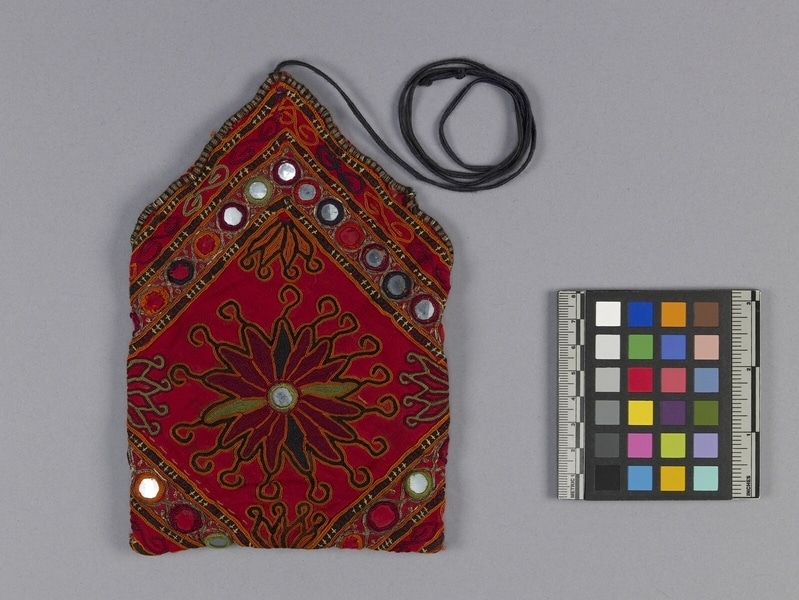Bag Item Number: 916/1 from the MOA: University of British Columbia


Description
Small, embroidered, red envelope style bag, made by folding and stitching three corners of a multi-coloured embroidered square together, leaving the fourth corner open as a flap. The central design motif is a hooked sun disc (circular medallion surrounded by numerous spiral ‘arms’) set within a square, which is surrounded by a row of mirrors and geometric border designs. The majority of the embroidered motifs are worked in fine chain stitch. All edges are finished with a heavy black cord that is couched in place with gold metallic thread. A narrow black cord is attached at the point of the flap. The bag is lined with tan and green machine printed cotton textile with a small floral pattern.
History Of Use
To hold money and/or small personal objects. The black cord that is attached at the point of the flap wraps around the bag to hold it closed. May have been part of a dowry. The printed cotton textile used to back this bag was undoubtedly produced in Russia, where there was a flourishing industry that produced printed textiles for the Central Asian market.
Narrative
According to Clarke Abbott of Tradewind Antiques, the person who collected this piece lived in Kabul in the early 1960s, doing ambassadorial work. He traveled widely throughout the area. He was killed in an automobile accident there, and no further information is available about him or his collection. The piece was subsequently acquired by Tradewind Antiques in Vancouver at an unknown date, and the Museum of Anthropology purchased it in 1984, when the business was liquidating its stock.
Iconographic Meaning
The sun disc represents the life-giving powers of the sun. Mirrors ward off evil spirits. The embroidered designs and style of workmanship are similar to pieces pictured in Afghan Embroidery, which are identified by the authors as Pashtun. The printed pattern of small floral motifs on the textile resembles patterns illustrated in Russian Textiles: Printed Cloth for the Bazaars of Central Asia that date from before the Russian Revolution.
Item History
- Made in Ghazni, Afghanistan ? before 1965
- Collected in Kabul, Afghanistan ? during 1965
- Owned by Tradewind Antiques before January 10, 1984
- Received from Museum of Anthropology Shop Volunteers (Funding source) and Tradewind Antiques (Seller) on January 10, 1984
What
- Name
- Bag
- Identification Number
- 916/1
- Type of Item
- bag
- Material
- cotton fibre, dye, glass, alloy metal and silk fibre
- Manufacturing Technique
- embroidered
- Overall
- height 18.5 cm, width 12.7 cm
Who
- Culture
- Pashtun ?
- Previous Owner
- Tradewind Antiques
- Received from
- Museum of Anthropology Shop Volunteers (Funding source) and Tradewind Antiques (Seller)
Where
- Holding Institution
- MOA: University of British Columbia
- Made in
- Ghazni, Afghanistan ?
- Collected in
- Kabul, Afghanistan ?
When
- Creation Date
- before 1965
- Collection Date
- during 1965
- Ownership Date
- before January 10, 1984
- Acquisition Date
- on January 10, 1984
Other
- Item Classes
- textiles
- Condition
- good
- Accession Number
- 0916/0001